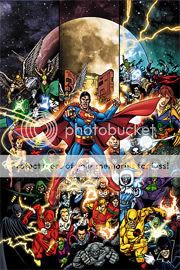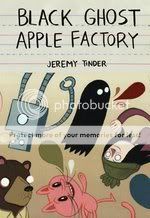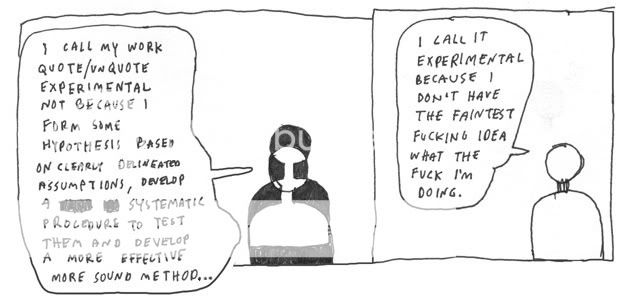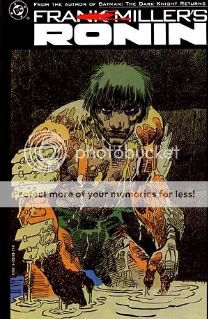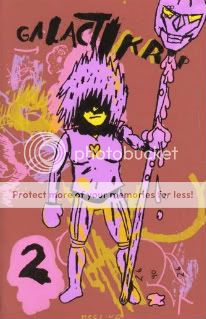Remember when I reviewed Brian Chippendale’s Galactikrap 2? It didn’t used to be available at the PictureBox store, but it is now…
Carnival of souls
* I really like the new trailer for M. Night Shyamalan’s The Happening, both because of the subject matter and because I admire the man’s chutzpah for including what in the ADD world of trailer editing have to be considered long takes. (Via Dread Central.)
* Bruce Baugh offers a thoughtful review of Eli Roth’s Hostel. I really appreciated his insights about the look of the film, the redeeming qualities of the American characters, the lingering effects of torture…just a wonderful analysis. Also worth reading is the comment thread where various people explain why they refuse to watch the film.
* Shock Till You Drop’s Ryan Rotten really liked Ryuhei Kitamura’s adaptation of Clive Barker’s Midnight Meat Train, which may be a good sign.
* Kevin Huizenga discusses the difficulty of making comics starring himself…in comic form!
* This week’s Horror Roundtable is about non-horror movies that hold their own in the horror department. It’s interesting to see the different directions people went with this.
Comics Time: DC Universe #0
DC Universe #0
Grant Morrison, Geoff Johns, writers
George Pèrez, Doug Mahnke, Tony S. Daniel, Ivan Reis, Aaron Lopresti, Philip Tan, Ed Benes, Carlos Pacheco, JG Jones, artists
DC Comics, April 2008
32 pages
50 cents
Four of the six* ongoing DC-published superhero titles I read are written by Grant Morrison and Geoff Johns. The former is as engaging as ever in All Star Superman and Batman (which reads better in chunks than it does in monthly installments), while the latter has truly come into his own with Green Lantern and the Superman series Action Comics (both of which are at this point my all-time favorite main-line runs of their respective lead characters). Morrison, for his part, is my favorite superhero writer, and I enjoyed his earlier collaboration with Johns on 52. So despite having no interest in Countdown to Final Crisis and some innate resistance to the DC approach to crossovers–they tend to be epic discussions of comics-y concepts like continuity and multiverses, as opposed to Marvel’s tendency to root its events, however perfunctorily, in more familiar ideas like the privacy/security tradeoff or post-9/11 paranoia or whether the ends justify the means–I naturally gave this book a whirl based on my appreciation of its writers. I even brought home a copy since Jim Hanley’s was giving them away for free!
It’s a fun book. I don’t think I knew that it was going to be a collection of teases for upcoming storylines rather than a self-contained story, or even a coherent prologue to a larger story. But this approach seemed like a smart way to get across several things:
1) The DCU is heading in a unified direction…
2) …dictated by storylines involving the big iconic characters rather than Donna Troy and the Pied Piper…
3) …and written by Grant Morrison and Geoff Johns rather than Jimmy Palmiotti and Justin Gray. Heck, given the reception of Countdown and its countless spinoffs, even Greg Rucka and Gail Simone, who are riding shotgun with vaguely connected tie-ins, seem like a huge deal.
DC Universe #0 seems to show that DC recognizes that its core characters/franchises (Batman, Superman, Green Lantern, perhaps Wonder Woman) are all pretty strong right now, so why not recalibrate the company’s crossover mojo around them rather than trying to force people to be interested in peripheral nonsense about nobodies? So instead of Monarch and Jason Todd, you get Batman grilling the ever-creepier Joker about a long-running plot thread involving a godlike supervillain gunning for the Dark Knight. You get one of Johns’s now-trademark multi-panel rapid-fire tastes of the rainbow of power rings now zipping around outer space. You get Superman in the future with the Legion of Super-Heroes (a concept I really don’t cotton to, but Johns has earned some credit in this department with his most recent Action arc), preparing to do battle with the hilarious fanboy-entitlement metaphor Superman-Prime. You get Wonder Woman’s godly forebears preparing to replace her with an army of 300 knockoffs, which makes for a funny visual at least. You get a creepy villain holding the scales of justice and trying to recruit other villains into yet another version of the Secret Society of Super-Villains, this one a Scientologyesque cult presumably dedicated to the awesome Jack Kirby villain Darkseid. You get an obliquely established return of Barry Allen, the long-dead Silver Age Flash, that plays itself out primarily through the shifting tone (and colors) of the narrative captions; it’s pretty funny to see Morrison do a mainstream-press-worthy character revival the same way he might establish an obscure plot point like, say, the link between the Undying Don and Ali-Ka-Zoom in Seven Soldiers. And you get the Spectre, but hey, they can’t all be winners.
As might already be apparent, the book is written in the crazy million-things-happening-at-once style of Morrison’s JLA Classified, Seven Soldiers, and those acid-flashback Batman issues from a few months ago, Johns’s Action Comics Annual and Sinestro Corps Special, and the pair’s 52. It’s possible to see the seams between the two writers’ work from time to time, but it takes some doing. I’m really happy to see Johns genuinely collaborating with Morrison and holding his own–it’s worth it for the horrified reaction of blogosphere snobs alone.
The art, needless to say, is of varying effectiveness. (Ivan Reis does what Ed Benes would like to do much better than Benes actually does, for example.) I think the George Pèrez cover is ugly and unnecessarily retro. However, I do like the design of the house-ad teaser pages interspersed throughout the comic to tout the relevant tie-ins–the text so blocky and matter of fact it’s almost funny. And they beat the hell out of either those orange Countdown-slogan teasers or the previous wave of motivational-poster-style teasers.
That being said, the notion that this is at all accessible to someone who isn’t a giant nerd is laughable. But I don’t care, since I am a giant nerd and I don’t give a shit about this particular book attracting new readers. That’s what manga is for! And even then we’re only talking about the first volume in a given series. I think the myth that “every issue should be written like it’s somebody’s first so that superhero comics would be more accessible” might make sense from a publishing perspective, but not necesarily a storytelling one, and maybe not even a publishing one anymore either given who the audience really is. I mean, any given fourth-season episode of Lost or Battlestar Galactica is completely incomprehensible to people who haven’t been following along, yet we fans don’t complain about that because we are fans and that’s who the shows are aimed at. Nobody gets upset because Death Note Vol. 7 isn’t a good jumping-on point, because that volume is for preexisting Death Note fans. Virtually everyone who picks up a comic called DC Universe is going to be someone who is already familiar with what a shared universe is, and that is totally fine. Now, the big corporate superhero companies can claim that the goal of something like DCU #0 is going to woo Johnny Dailynewsreader, but we don’t have to play along by evaluating the book negatively based on that standard. The standard I evaluated it on is “here’s a book by two of my favorite writers at DC that leads into their upcoming storylines on various titles–does it make me happy I’m reading them?” The answer was yes.
* All Star Batman & Robin, the Boy Wonder and Ex Machina
Carnival of souls
* Infocult’s Bryan Alexander tracks developments in the case of Josef Fritzl, the Austrian man who imprisoned his daughter and their inbred children in hidden chambers in his cellar for over two decades. I’m as astonished by this story as I have been by anything I’ve read in all of my years following macabre crimes. To my surprise, the most outlandish details of the initial reports have not just been confirmed, but surpassed.
* Though I haven’t seen any of the Masters of Horror films that And Now the Screaming Starts’ CRwM is talking about in his review of John Carpenter’s Pro-Life, I greatly admire the way he goes after mainstream critics for myopically focusing on “horror as current-events report” and horror filmmakers for catering to that particular fixation.
* I like the sound of I Love Sarah Jane, a short film about a lovestruck junior-high kid’s experiences during a zombie apocalypse, screened at the Independent Film Festival of Boston and reviewed by Not Coming to a Theater Near You’s Katherine Follett.
* Finally, amen. (Via Topless Robot.)
Carnival of souls
* Big, sad news for film and TV blogospherians: Matt Zoller Seitz, proprietor of the best film and TV blog on the web by a country mile, The House Next Door, is retiring from journalism and criticism to become a full-time filmmaker. Frequent co-blogger Keith Uhlich will take his place as editor of the site.
* At his official website, there’s another huge interview with Clive Barker. He announces a new, wholly original upcoming comic book project with his frequent publisher IDW, touches on his upcoming film projects, his paintings, the delayed release of Midnight Meat Train, and Abarat Book 3, but the bit I was most interested in, and happiest to read, was about his voice. If you’ve listened to any interviews with the man lately, quite frankly he sounded terrible, even more gravelly than usual. Turns out he had benign polyps on his vocal cords that have since been removed, making it easier for him to talk, sleep, and breathe. I sure do wish him well. (Via Dread Central.)
* Actresses Shauna MacDonald and Natalie Mendoza will both be returning for The Descent 2, which is…interesting.
* There’s a new Incredible Hulk trailer out there, and I know I’m supposed to say I’m soooooo over this movie (and Edward Norton), but I’m not. I want to watch CGI Ed Norton smack around CGI Tim Roth and I don’t care who’s feuding with whom. (Via Arrow in the Head.)
* B-Sol at the Vault of Horror serves up Part 2 of his look at the history of the modern zombie movie, starting with Dawn of the Dead and working its way through the Italian zombie flicks and the splatstick horror-comedies of the ’80s.
* Finally, Bryan Finoki muses at length about the physical and aural architecture of America’s torture chambers. (Via Andrew Sullivan.)
Comics Time: Black Ghost Apple Factory
Black Ghost Apple Factory
Jeremy Tinder, writer/artist
Top Shelf, 2006
48 pages
$5
Jeremy Tinder’s debut graphic novella Cry Yourself to Sleep displayed a knack for slightly off-kilter observational humor, a fine grasp on cute character designs, and an entertaining way of combining the two. Stripped of that longer effort’s stabs at coaxing something deeper out of the yuks, BGAF feels slighter (is slighter, I suppose), but compensates for that by reading like a funny Jeffery Brown convention mini. Several of the short strips contained here mine familiar “cute animal is actually a vulgar cad” territory to laugh-out-loud effect–I particularly liked the shot of a nude woman fellating a bunny rabbit with such enthusiasm she looks like she’s eating his crotch. The stand-out strip, though, is the most serious one, which centers on a love quadrangle involving a lovelorn elephant. In its eight pages of anthropomorphized friends/lovers sharing one last bittersweet night before a separation, you get something that reads like half-Chunky Rice parody, half-Chunky Rice tribute. That’s a pretty enjoyable combination for this reader.
Carnival of souls
* Tom Spurgeon interviews Comic Book Legal Defense Fund Executive Director Charles Brownstein about the dismissal of the Gordon Lee case. As I read the interview I thought of a different kind of dismissal the case received–from a former coworker of mine who, when word of the first charges first broke out, sneered that the Nick Bertozzi comic involved was pornography, that Lee deserved what he got, and that the CBLDF should never have taken the case. Not to put to fine a point on it, but suck on it, schmuck.
* Film scholar and Tolkien-film expert Kristin Thompson weighs the enthusiasm for his new Hobbit gig expressed by director Guillermo Del Toro in this MTV interview and elsewhere against the skepticism expressed by Salon’s Andrew O’Hehir. If O’Hehir’s piece stuck with its initial focus on Del Toro’s previously voiced distasted for heroic fantasy, or a critique of his existing films, I’d be right there with him, but instead it veers off into things that really have nothing to do with the potential quality of his Hobbit film, like the fact that lawsuits had been filed and Peter Jackson is successful.
* David Bowie’s legendary live set from a 1972 gig in Santa Monica is being officially released!
* Sea monsters in Manhattan! It’s an inflatable art piece by Joshua Allen Harris. (Via And Now the Screaming Starts.)
Carnival of souls
* Clive Barker made some news at Fangoria’s Weekend of Horrors convention this past weekend regarding his “Books of Blood” film series. In addition to the upcoming Midnight Meat Train and in-the-works Book of Blood, Barker announced that Anthony DiBlasi has been tapped to write and direct the long-gestating adaptation of “Dread,” once again confirmed the also long-gestating plan to adapt “Pig Blood Blues,” and revealed that the fifth film in the series will be an adaptation of an unlikely choice (to me at least), “The Madonna.”
* Real life horror: An Austrian man kept his daughter prisoner in his windowless cellar for 24 years–along with the seven children he fathered with her through rape. All of this was unbeknownst to the man’s wife, supposedly. The story is so horrifying and unbelievable that it is, well, hard to believe, and I wouldn’t be surprised if initial reports turn out to be substantially inaccurate. But for now, here is your quote of the day:
Once inside the dungeon, police reported, they found all the passages extremely narrow, the ceiling is no higher than 5ft 6ins (170cm) and the floors uneven. They have found a makeshift shower room, cooking rings for the secret family to heat food, and a room lined entirely in rubber whose use is unknown.
(Via Keith Uhlich.)
* Go, look: An Anders Nilsen comic strip!
* Water monster news: Scientists are defrosting and preparing to examine the 34-foot colossal squid they found a while back. (Via Rob Humanick.)
* Finally, Fantagraphics has a pair of incredible deals up on their website: Get a set of all seven (totally, totally awesome) Love & Rockets digests for $85, and/or a set of all ten volumes (so far) of Mome for $100. Either option is such a terrific gift idea it’s not even funny.
Comics Time: Batman and the Monster Men
Batman and the Monster Men
Matt Wagner, writer/artist
DC, August 2006
144 pages
$14.99
A retelling of the first Batman story to involve superpowered antagonists way back when, Batman and the Monster Men would be the baseline of quality for Batcomics in a better world than this one. It’s unlikely to stick in your craw in terms of its depiction of Batman’s sadness or mania, which for me at least is the effect achieved by the best Batman stories. Nor does the scripting necessarily rise above the usual comic-book treatment of such stock figures as Mad Scientist, Gotham Mobster, Spunky but Naive Heiress, Crooked Commissioner and so on. The narration tends to spell out what’s happening and why, and the prose isn’t stylish enough for me not to be bugged by that. And Wagner’s art is sometimes startling crude.
But–well, if you’ve stuck around long enough to hear the “but” in the first place, my guess is this book may be for you. Reason number one would be Wagner’s art, crudeness and all. His Batman is a big hunk of marble that throws itself at its targets with a real wallop. Though we’re about as far from Paul Pope’s fashion-textbook realism, the combination of Wagner’s meaty design and Dave Stewart’s plain black and gray color scheme for the outfit truly makes Batman feel like a big, fast guy who puts on a creepy outfit to punch people in. Given that the threat in the story is basically three or four big huge mutants who punch people too, the effect is sort of like watching a Kimbo Slice streetfighting video on YouTube. That’s pretty much how I want a Batman comic to feel.
Wagner also somehow pulls off the delicate alchemy of the “detective” aspect of Batman’s idiom, having the character follow a trail of clues that we of course would never trace to the same conclusion but never coming across as manipulative or shoddily constructed. If the whole thing kind of pales in comparison to Frank Miller and David Mazzuchelli’s Batman: Year One—the project to which it seems meant to be a sequel in terms of look, tone, and time frame—it’s also astute enough to fairly accurately ape that feel in the first place. Even the occasional bizarre and wonky facial expression or disproportionate body harkens back to the primitive Golden Age artists of yore. If I were presented with Batman comics like this on a regular basis, unspectacular but entertaining and satisfying efforts akin to a good solid Law & Order episode, I would be a very happy Batfan indeed.
Carnival of souls
* Guillermo Del Toro is directing The Hobbit and its sequel. I don’t know how to feel about this.
* I am at least enthusiastic about the idea of the second film in this particular package, which lots of people seem really confused about but which seems to be pretty clearly about both Gandalf’s doings when he wasn’t hanging with the dwarves during the events of The Hobbit proper and the subsequent doings of, I’m guessing, Gandalf and Aragorn prior to the start of The Lord of the Rings. That’s what I got out of Del Toro’s interview on TheOneRing.net, anyway. (Via Kristin Thompson.)
* “Eli, Eli, lama sabachthani?” Absolutely hilarious.
* Battlestar Galactica‘s Nicki “Cally” Clyne blogs her (spoilery, duh) thoughts on last week’s episode.
* Tom Spurgeon thought the New York Comic Con was a terrible place for people who enjoy comics.
* The Onion A.V. Club’s Scott Tobias has a piece on The Blair Witch Project, the scariest movie I’ve ever seen, that’s one of the better things I’ve read on the movie to date. (Via Keith Uhlich.)
* Here’s the second half of Jimmy Kimmel’s interview with Lost‘s Carlton Cuse and Damon Lindelof. I like the tone of it better than the first half.
* Final Girl’s Stacie Ponder presents a Clive Barker edition of her regular feature, Awesome Movie Poster Friday.
* Ken Parille has put together a striking collection of images to illustrate the influence, unconscious or otherwise, of cartoonist Daniel Clowes on cartoonist Rich Tommaso.
* Jordan Crane’s cover for Uptight #3 is fantastic.
* Finally, this week’s Horror Roundtable is about the one horror-movie prop we’d most like to own. I’ll give you three guesses as to what mine is, and the first two don’t count.
Comics Time: Ronin
Ronin
Frank Miller, writer/artist
DC, 1984
302 pages
$19.99
If The Dark Knight Strikes Again is Frank Miller’s brain on SPX, I suppose Ronin is Frank Miller’s brain on Shogun Assassin. I’d say Lone Wolf and Cub proper or some other manga touchstone, but the thing is that my own comparative ignorance of Japanese comics and Miller’s enormous influence on Western ones make it hard for me to see evaluate this formally as anything but a Frank Miller Comic that happens to use samurai and Akira-style science fiction.
It’s a very good Frank Miller Comic in fact. Back then his art had this doodly/sketchy quality—lots of little loops and bubbles and curlicues—that had yet to solidify into the hyperrealist noir of the first Sin City chapters in Dark Horse Presents and thence to recede to the chunky bigfoot self-satire of DKSA or the later Sin City books. It’s a bold style, perfect for conveying enormity by expanding the blobby details to the edge of the page or isolating action by stripping them away and letting the remaining figures slash through them. It’s also beautifully colored by Miller’s now ex-collaborator Lynn Varley; no one has used greens this effectively before or since.
Storywise it combines the familiar Japanese pulp tropes mentioned above with the uniquely Millerian idiom of topless black bondage Nazi gangs (cf. The Dark Knight Returns, Sin City), evil corporations painted with an hilariously broad satirical brush (cf. Hard Boiled), and sinister omnipotent female computer programs (cf. Martha Washington–man, if in some future FM Batman comic the Batcomputer ever gets referred to as “she,” watch out). But moreso than in any Miller comics save perhaps his collaborations with David Mazzuchelli, there’s a refreshing space left for the human element. While there’s obviously a lot of “he is the Hero, he is everything” to be found here, much of the plot is driven by the comparatively quotidian doings of the Aquarius Complex’s worker bees: middle management, staff psychiatrists, laborers pissed off at the treatment of the fellow workers, an idealistic scientist and his security-guard girlfriend whose story of success-driven estrangement would fit nicely into a late-’90s period piece about a dot-com startup. So it’s easy to forgive some narrative lapses, like a jarring bit of told-not-shown infodumping about how the ronin entered the modern world whose raison d’etre only becomes apparent at the end of the story, and simply focus on the pleasures of the art and the tempered-gonzo writing. Capping it all off is a brancinglysudden ending and final image of triumph-through-simply-existing that I really wish more genre comics would ape. I will enjoy rereading this comic every four years or so until I die.
Lost: A tale of two interviews
Yesterday, two interviews with Lost head writer Damon Lindelof and showrunner Carlton Cuse popped up that seem almost tailor-made to be illustrative of two conflicting schools of Lost fandom.
On the one hand you have comedian Jimmy Kimmel’s interview with the pair for TV Guide. This is the first question he asks:
The island heals some people and doesn’t heal others. For instance, Ben needed an operation from Jack to beat cancer, but it seems like Sawyer gets injured every sixth episode and by the next, he’s fine. Is that just a TV thing?
The last sentence kind of skews the question in a process-oriented direction rather than just an “OMG what’s going on???” one, but I still think it points to the outlook of the kind of fandom that has me so flummoxed lately. To the extent that they do have considerations other than plot those considerations are still focused on logistical issues–trying to figure out why and how things happened behind the scenes. Simply mulling over and discussing the emotional, intellectual, and certainly the aesthetic impact of what we’ve seen doesn’t enter into it. In many ways, it’s like interviews with superhero comics writers, where nearly all the questions are dedicated to either “What’s gonna happen to Wolverine next?” (in-world questions) or “How did you decide to do that to Wolverine?” (making-of questions), with no real critical response to speak of (unless you count “tearing the internet in half,” whether positively or negatively, as a qualitative observation, which you shouldn’t).
But Kimmel’s interview gets at some of these distinctions itself. For example, there’s this blockbuster section:
Kimmel: People come up to you all the time with theories. Has anyone come close to cracking the code?
Cuse: I think there are two assumptions that people make that are incorrect. One is that the whole answer to Lost reduces down to a sentence. It’s not like searching for Einstein’s Unified Field Theory. And the second is that you have enough information to “crack the code.” The flash-forwards completely changed your notion of the show. So how could you do some accurate theorizing before you even knew those existed?
My sentiments EXACTLY! Seriously, it’s almost eerie to be echoed by one of the show’s head honchos just, like, two weeks after this first even occurred to me. But the best part of Cuse’s quote is that it goes beyond refuting the Theorizers on a logistical level (you can’t possibly know because you don’t have all the information yet) and rejects that approach on a philosophical level as well (you can’t possibly know because it doesn’t work that way anyway).
Furthermore, when Kimmel presses the issue, Cuse responds:
Even though we get asked a lot of questions about the mythology, Jimmy, we’re really trying to write a character show. We spend about 80-90 percent of our time talking about how the characters are lost in their own lives as people. The mythology is kind of the frosting on the cake.
About the only discussion of Lost I’ve seen that treats the show this way was from Andrew Dignan’s now-defunct weekly Lost reviews at The House Next Door, which really bums me out. Now, I don’t think the show would be as important to me if the mythology weren’t there–as a character show it’s not up there with the great HBO dramas–but this is such an amazingly undervalued way of approaching the series–including by the creators themselves, no matter what they say to the contrary, so long as they continue to participate in stunts like USA Today’s “post your theory, get comments from the producers” contest.
(Now there is, of course, the “Lindelof’s Mom” viewer, who supposedly tunes in to the show to see who hooks up with whom and cares not one whit for the monster or the Hatches or any mythology aspects. But as a friend of mine pointed out to me, the kinds of people who fixate on “who falls in looooooove” are almost as bad as the clue-hunters, and they’re certainly a different beast than people who consider the overall effect of the show rather than the romance aspect alone. Theorizers and Shippers–the Scylla and Charybdis of contemporary genre fiction.)
And I also appreciated this bit from Lindelof, regarding the freeze-framed, digitally processed search for “clues” in every episode:
We would love in moments like that to go, “Yes. We knew we’d be introducing the idea of the Dharma Initiative in the second season premiere and we wanted people to go back to the pilot and see that the symbol had been burned into the fuselage.” But if we had known, we wouldn’t have done it in such an oblique way. Sawyer would’ve went [adopts Southern twang], “Hey, what’s this?” We want people to see our Easter eggs.
This is a separate aspect of clue/theory-based fandom that irks me: the tendency not just to see hoofprints and think of zebras instead of horses, but to invent zebra prints when there aren’t any there. Perhaps the most infuriating discussion about Lost I’ve ever had took place on a message board I hang out on, where I spent two or three weeks being told that there’s no way baby Aaron could be one of the Oceanic Six, basically because he wasn’t a ticketed passenger. Now, the label “Oceanic Six” is, in the world of Lost, a media-generated nickname for the survivors, so for Aaron to not be considered one of them would therefore mean the international news media ignored a baby born on a deserted island to a plane crash survivor–basically the greatest human-interest story ever–on the kind of technicality that only people who sit around making anagrams out of supporting characters’ names would appreciate. The adamant refusal to consider basic tenets of human behavior, instead focusing on clues and rules and regulations like the show is a board game, is so baffling to me.
Interview number two is conducted by the Onion A.V. Club’s Noel Murray. This interview is distinguished from every other interview I’ve seen with Lost creators, including the two I myself have conducted, in that it doesn’t as a single in-world question. Also, the making-of questions aren’t all variations on “do you know where this is going?”, which is in a way just an in-world question in disguise. The resulting answers make for fascinating reading, and I’m so enthusiastic about it I’m basically going to reproduce vast swathes of it while encouraging you to click over and read it yourself.
For example, here’s Lindelof on the difference between flashforwards and flashbacks as storytelling mechanisms:
…whereas the flashbacks before had been an emotional storytelling technique—like, “Here’s how Sawyer became a con man, here’s the time that Jack ratted out his father, here’s when Kate held up a bank”—on a story level, they weren’t that complicated. They were sort of the one thing the audience could grasp onto, no matter what sort of wackiness was happening on the island. The flash-forwards are the exact opposite of that. When you see [Character X] in the future killing people for [Character Y], that’s all story. Or when you see [Character A] being approached by [Character B], that’s all story. So the show actually becomes vastly more complicated.
All the flashforwards so far have shown the characters involved in extremely tense and discomfiting places emotionally so it’s easy not to notice that they’re now plot pieces as well as character pieces, but this is a point well taken.
Then there’s Cuse on the different difficulty levels, for want of a better term, for the show’s mysteries:
I also think that it’s rewarding for the audience to not always be frustrated and behind. We have certain mysteries on the show that we hope the audience figures out on their own, and can have the satisfaction of saying “Aha! I knew that! I knew that the guy on the boat was going to be [Character Q]!” But there are other times when we have real surprises, like [Character U] shooting [Character V] and [Character W], where we go to great pains to make sure that nobody sees it coming, so you’re genuinely surprised. We intentionally mix up the degree of difficulty in solving the puzzle.
I still find it immensely frustrating when the show is spoiled by its own opening credits, but again, this is a point well taken.
The pair also talk candidly, and to my mind somewhat disappointingly, about the impact fan reaction can have on the story itself. While they both disavow Lost messageboards as overly plot-centric and nitpicky, they also admit that the public reception of characters–they call this “market fluctuations”–can lead to their premature exit from the show. So too can outside considerations like actors simply wanting not to live in Hawaii anymore, which bums me out enormously, as such things have ever since I found out that the Frankie Pentangelli role in The Godfather Part II was originally supposed to be Clemenza. On the other hand, actors who really click in a role sometimes see their parts get beefed up, and for whatever reason I have no problem with that–I suppose because it’s an issue of collaborating artists, rather than a business concern or an audience concern.
There’s a lot more, including the now ever-present discussion of how having a set endpoint has altered and reinvigorated the storytelling dynamic, an interesting passage about how the DVD/download viewing model is really going to be the norm once the show ends and the actual week-to-week airings are a historical fluke by comparison. You should read the whole thing.
(Links via Whitney Matheson)
Carnival of souls: Special “Frank Milla Thrilla” edition
* A whole bunch of Frank Miller/The Spirit news came out of New York Comic Con, including some more posters and an enjoyably Sin City-ish teaser trailer. (Via AICN.)
* For my money the most interesting Miller tidbit has to do with another project entirely: Miller himself is hoping/planning to direct an adaptation of his and Geof Darrow’s gonzo sci-fi masterpiece Hard Boiled. As MTV points out, this project was originally associated with Nicolas Cage and David Fincher. (Also via AICN.)
* And at Entertainment Weekly, Miller and his producer Deborah Del Prete talk turkey about the Spirit adaptation, while Miller reveals he’s 122 pages into a new book that’s a “love letter to New York”–presumably not Holy Terror, Batman!, then–and that he’s finished writing Sin City 2 with an eye on an eventual third film as well. (Via Kevin Melrose.)
* Speaking of films that irritate Ron Rosenbaum, Uma Thurman tells MTV that Quentin Tarantino is indeed working on that big final all-in-one deluxe DVD version of Kill Bill, aka The Whole Bloody Affair, AND at least one of his proposed anime prequel/sequel/whatevers involving the KB characters–the latter will be used as a bridge/intermission to create the former. Based on Tarantino’s previous statements and Thurman saying she hasn’t done any voice work for the cartoon, it seems like Bill will be the subject of the new material rather than the Bride. (Via Rob Bricken at Topless Robot.)
* Ammon Gilbert of Arrow in the Head pays homage to one of the two great ultraviolent Communist-invasion action films of the ’80s, Red Dawn. (That’s the one involving teenaged Patrick Swayze, Charlie Sheen, C. Thomas Howell, Lea Thompson, and Jennifer Grey avenging the imprisonment of Harry Dean Stanton–and who wouldn’t?–not the one involving Chuck Norris shooting people in shopping malls.)
* The Blot‘s Tom Neely keeps on killin’ the game with his weekly comic strips. Goddammit, look at those palm trees.
* Water Monsters in the News: Loren Coleman notes a report of an alligator in a New Hampshire pond, which is neat enough, but in so doing he breaks down the differing types of unusual-alligator reports: stray pets or zoo animals vs. expanding habitat vs. actual out-of-place breeding populations vs. genuine cryptid lake monsters. Dreamy stuff.
* All Too Infrequent T-Shirt Blogging: Whitney Matheson notes that CNN.com now has T-shirt-making functionality for some of its video-news headlines. That is very bizarre and very cool.
* Finally, I hope to have a nice Lost post up later today in time for the return of the show–I was gonna include that stuff here but it probably merits its own post. So stay tuned.
Comics Time: Little Things
Little Things
Jeffrey Brown, writer/artist
Touchstone/Simon & Schuster, March 2008
352 pages
$14
It had been a while since I read a full-length Jeffrey Brown comic starring Jeffrey Brown, and I’d forgotten what a unique experience a Jeffrey Brown autobio page is. Reproduced at roughly the same size at which they’re drawn, Brown’s pages are almost always stuffed with six square panels, which are themselves crammed with penned detail. But despite containing so much visual information, the casual feel of Brown’s line and portraiture make the page come across more mellow than manic. Meanwhile, and particularly when compared to the many other sketchy (by design or necessity) slice-of-life efforts that have sprung up in Brown’s wake, his pop-eyed characters pop from their backgrounds, which themselves feel like fully realized and inhabitable spaces. The total effect is really accomplished and unique, and it turns out I missed it quite a bit.
This is the part of the review where I was gonna argue that in these ways the art mirrors the story, or nonstory, presented in the book itself: a sea of detail saved from unpleasant obsessiveness by a breezily directionless presentation, against which notable specifics stand out. This observation has the virtue of being true, but I feel like reading that much into what’s going on sort of defeats the purpose of the book. While Brown argues in his introduction that the point is that tiny, seemingly insignificant moments–coffee with friends, awkward movie-watching experiences–can take on the same importance as truly life-changing events–gall-bladder surgery, witnessing a horrific car crash, meeting the father of the mother of your child–to me the book ultimately demonstrates something slightly but vitally different: Those insignificant moments remain insignificant, yet occupy a disproportionately high rank in our mental catalog of memories, and the resulting stew of momentousness and meaninglessness is in the end what makes our lives what they are. Both are indispensable.
Sean goes Topless
My debut post at the wonderful nerd-culture site Topless Robot is up: The 11 Most Awful Songs from Geek Movie Soundtracks. I’d say “enjoy,” but I’m not sure that’s applicable.
Carnival of souls
* I’ve seen a lot of OUTRAGE from horror fandom about the recent successes of PG-13 horror movies, perhaps best represented by the Prom Night remake from a few weeks back. Most of it consists of mouthbreathingly simplistic “BLOOD AND TITS EQUALS WIN”-type extreme-mongering rather than any kind of informed consideration of whether PG-13 movies might possibly be scary. But B-Sol at Vault of Horror takes an entirely different view of the problem with PG-13: They’re slasher movies explicitly geared at young teenagers.
* Jim Henley defends 24 against the accusation that it’s directly responsible for torture at Gitmo and elsewhere, as recent reports have claimed. I totally agree with Jim: as with other cases involving movie-inspired violence, I think it’s a case of people predisposed to violence gravitating toward violent art, not violent art inspiring violence in the first place. And while I don’t give a good goddamn about the show itself, some regular viewers in Jim’s comment thread point out temporal discrepancies in terms of what was going on in the series by the point it was supposedly inspiring torture techniques.
* Scott Pilgrim creator Bryan Lee O’Malley reviews Cloverfield! I think he’s right about the film’s visceral impact and wrong in saying the characters aren’t vapid (man, that’s kind of leaving things wide open for people with the same complaint about SP, isn’t it?), but you’ve gotta love his disclaimer:
Note to complainers: don’t take this as an invitation to pontificate on why you hated this movie, because I don’t actually care
* This week’s Horror Roundtable is all about horror movies we remember watching as kids. Between the Roundtable proper and the comment thread, the moral of the story is clearly that everyone loves The Monster Squad and The Blob.
Comics Time: Galactikrap 2
Galactikrap 2
Brian Chippendale, writer/artist
self-published, October 2007
72 pages
$8
This is what those “fun” superhero comics that nobody but predominantly superhero-comics bloggers reads would look like in an alternate universe where Gary Panter took over as Marvel house artist instead of John Romita Sr. and Los Bros Buscema following the departures of Jack Kirby and Steve Ditko. The major difference, of course, is where in those books the action-humor blend is the primary selling point, here it’s simply the tool Chippendale uses to set up the action beats and environments that are the meat of his cartooning. The yuks and fights are the means to an end, not an end in themselves, but they also happen to be really really crackerjack, which is more than you can say about this book’s Big Two brethren.
Plotwise, this is a follow-up to Chippendale’s earlier Battlestack Galacti-crap, a story of two tribes (cue Frankie Goes to Hollywood) of costumed weirdoes battling it out over the right to sell cupcakes in a particular area of their sci-fi city. It’s exactly as nonsensical as it sounds, which is totally fine because the point is the drawing, and man, it’s a pip. This issue kicks off with a brief silkscreend color section that evokes the full-color openings of manga volumes, a comparison subverted here by the supreme ridiculous of the subject matter (one of our warring tribes, Teamy Weamy, is debating whether to change their name to Team Tomb or Team Tummy). The rest of the comic comprises three separate, vaguely interlocking vignettes, each defined by the way they use sequences of panels to pace action. In the first (back at the cupcake stand from the first issue) a bug-laden “bugcake” is lobbed past a stunned onlooker at the head of a disgruntled customer; Chippendale draws the action out over several panels to call attention to its kinetic silliness. This is in contrast to the next big bit, in which panel after panel is left silent while two characters are placed on hold as they call a credit card company to find out why one of their cards has been denied–here the drawn-out sequencing conveys boredom rather than action. Things kick into high gear in the second section, which involves a pair of super-types infiltrating an underground lair and battling robot-type dudes. Chippendale’s chunky, crunchy line is a surprisingly effective canvas for action choreography, making the space in which the action takes place feel solidly constructed and lived-in while lending a certain palpable oomph to various ninja stealth antics, laser dodges, and one really memorable blast at a bad guy. the third and final sequence is mainly an excuse to create a convenience store shaped like Godzilla called Snackzilla, I guess, but it too has a laugh-out loud depiction of slapstick involving a bunch of characters getting bonked on the head with a baseball bat and sent tumbling down a hole in the floor by a secret member of a rival gang. After a funny, deadpan two-page bonus comic by Ben Jones about a dog who will become the Chosen One but at this point mostly stands around with his tongue lolling out, the comic ends with another two-page color section; as with the first issue, this finale displays Chippendale’s knack for drawing figures in freefall, but this time uses it to set up a funny gag about one falling character remembering he can fly mid-plummet.
The character designs are all funny and easy to parse–I sort of want to see these folks cross over with the gang from Powr Mastrs; the environments, particularly in a trio of stand-alone pages toward the end of the book, are immersive and mysterious; and since Chippendale is working with basically one or two large panels per page it’s probably a lot easier than Ninja or Maggots for your average civilian to follow. This is the kind of minicomic you’ll read from cover to cover each time you come across it wherever you keep your minicomics. If you spot this at a con you should buy it.
Carnival of souls: special “quality over quantity” edition
* Todd VanDerWerff at the House Next Door has posted a very thoughtful and in-depth review of Friday’s excellent Battlestar Galactica episode.
* Tom Spurgeon does another one of his must-read review rampages.
Carnival of souls
* Big news: The Gordon Lee case has been dismissed, presumably due to egregious prosecutorial misconduct. This is a big day for the Comic Book Legal Defense Fund and a big day for comics, a medium that stands on shaky ground with regards to free speech issues. (Via Tom Spurgeon.)
* Fangoria speaks to Clive Barker about the current status of the Hellraiser remake, his Harry D’Amour/Pinhead epic The Scarlet Gospels, the next Abarat book, and the film adaptation of The Thief of Always.
* Tom Spurgeon reviews Joshua W. Cotter’s knockout Skyscrapers of the Midwest.

